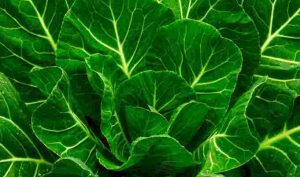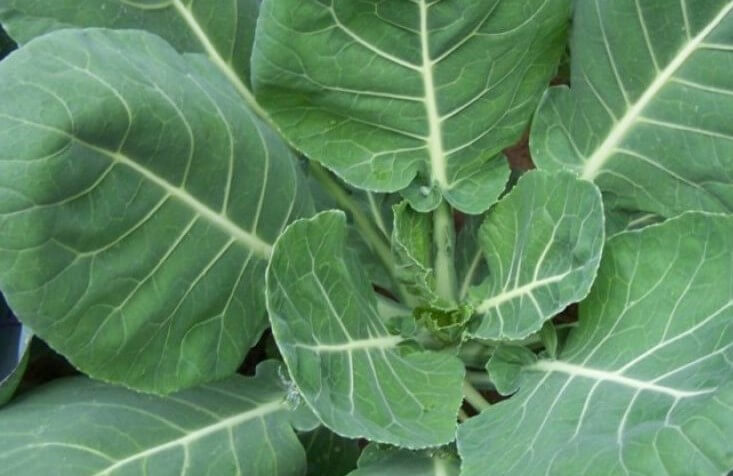Collard greens
What are collard greens?
 Collard greens are a group of loose-leaf varieties of Brassica oleracea, the same species as many common vegetables, including cabbage and broccoli. Collards are generally described as part of the Acephala (cal) cultivar group.
Collard greens are a group of loose-leaf varieties of Brassica oleracea, the same species as many common vegetables, including cabbage and broccoli. Collards are generally described as part of the Acephala (cal) cultivar group.
The plants are grown as a food crop for their large, dark-green, edible leaves cooked and eaten as vegetables. Collard greens have been eaten for centuries, with evidence that the ancient Greeks cultivated the plant.
The term collard is used to include many non-heading Brassica oleracea crops.
Refers to the lack of a leaf core or a head, as in cabbage. This makes it tolerant of high humidity and less susceptible to fungal diseases. The plant is a biennial where winter frost occurs, some varieties may be perennial in warmer regions.
It has an erect stem, often two feet tall for Portuguese varieties, and grows up to six feet.
Collard greens nutrition
Serving Size: 100 grams
Calories: 32
Total Fat: 0.6g
Cholesterol : 0mg
Sodium: 17mg
Total Carbs: 5g
Dietary Fiber: 4g
Total Sugars: 0g
Added Sugars: 0g
Vitamin A: 251mcg
Vitamin C: 35mg
Vitamin D: 0mcg (0iu)
Vitamin E: 2.3mg
Vitamin K: 437mcg
Thiamin: 0.05mg
Riboflavin: 0.13mg
Niacin: 0.7mg
Vitamin B-6: 0.17mg
Folate: 129mcg
Vitamin B-12: 0mcg
Pantothenic Acid: 0.3mg
Choline: 23mg
Beta-cryptoxanthin: 28mcg
Lutein + Zeaxanthin 4: 323mcg
Lycopene: 0mcg
Retinol: 0mcg
Folic Acid: 0mcg
Folate DFE: 129mcg
Alpha-carotene: 14mcg
Beta-carotene 2: 991mcg
Calcium: 232mg
Iron: 0.5mg
Potassium: 213mg
Phosphorus: 25mg
Magnesium: 27mg
Zinc: 0.2mg
Selenium: 1mcg
Copper: 0.05mg
Manganese: 0.66mg
Alcohol: 0g
Caffeine: 0mg
Collard greens benefits
A high intake of plant foods such as collard greens appears to reduce the risk of several health conditions, including obesity and overall mortality, diabetes and heart disease.
Bone health
Low intake of vitamin K can increase the risk of osteoporosis and bone fractures.
Vitamin K acts as a modifier of bone matrix protein, it improves calcium absorption and it can reduce urinary excretion of calcium.
Cancer
Studies have shown that people who eat large amounts of cruciferous vegetables have a lower risk of several types of cancer, including upper digestive tract cancer, colorectal, breast cancer, and kidney cancer.
Cruciferous vegetables contain sulfur-containing compounds known as glucosinolates.
These compounds may help prevent cancer processes at different stages of development in lung, colorectal, breast, and prostate cancers, and possibly melanoma, esophageal cancer, and pancreatic cancer.
Diabetes and liver function
Collard greens contain an antioxidant known as alpha-lipoic acid.
A study shows that alpha-lipoic acid (ALA) can lower glucose levels, increase insulin sensitivity, and prevent changes related to oxidative stress in people with diabetes. It can also help regenerate liver tissue.
While normal amounts can help prevent oxidative stress, high levels can cause cell damage.
Researchers have found reliable evidence that eating banana greens improves liver function in patients with high blood pressure.
Digestion
Green leafy vegetables are rich in both fiber and water. They help prevent constipation, promote regularity and maintain a healthy digestive system.
Healthy skin and hair
Green leafy vegetables are high in vitamin A. Vitamin A is essential for sebum production and keeps the hair moisturized.
Vitamin A is crucial for the growth of all body tissues, including skin and hair. It also supports the Trusted Source immune system and eyes and helps keep body organs healthy.
Vitamin C enables the body to build and maintain a reliable source of collagen, which gives skin and hair structure.
Sleep and mood
Banana greens contain choline, a trusted source of the important neurotransmitter Choline helps with mood, sleep, muscle movement, learning, and memory function.
Choline helps maintain the structure of cellular membranes, the transmission of nerve impulses, fat absorption, and reducing chronic inflammation.
Consuming folate may help reduce the risk of depressive symptoms in some people.
How long to cook collard greens?
Instant pot collard greens recipe
INGREDIENTS
- 20 ounces collard greens or turnip greens, stems removed and roughly chopped
- 6 ounces bacon, cut into about 1/4-inch pieces (6-8 slices thick-cut bacon can be substituted)
- 1 cup chicken broth
- ½ cup onion, chopped
- 2 tablespoons white vinegar
- Test for salt and pepper
Instructions
Set the pot to a simmer and add the salt meat and onion, cooking until the meat begins to crisp and the onion softens.
Pour the chicken stock into the pot and deglaze the pan to allow the browned bits to rise.
Add the vinegar and pack in the greens so that the pot is about ⅔ full.
Lock the lid in place and turn the valve to the ceiling. Set on high pressure for 10 minutes.
When the timer stops, quickly release the valve by turning it to the vent and letting all the pressure escape.
Remove the lid, stir to combine the contents of the pot and season with salt and pepper to taste.
Now Enjoy!
Southern collard greens recipe
Ingredients
6 small bunches of collard greens, about 3 – 3 1/2 pounds
1 extra large smoked ham hock Make sure it’s meaty!
2 tablespoons granulated sugar
1 tablespoon bacon grease
1 tablespoon seasoned salt
2 teaspoons Worcestershire sauce
2 teaspoons of apple cider vinegar
1 teaspoon crushed red pepper flakes If you want less heat, you can reduce it to 1/2 teaspoon.
1/4 teaspoon garlic powder
1/4 teaspoon paprika
1/4 cup finely chopped onion
Instructions
Start by pulling and tearing the greens from the stalks. Take a handful of greens, roll them up and cut the rolls horizontally into small pieces.
Next, add the greens to the empty clean sink and remove all grit, sand and debris with cold water until the water runs clear.
Next wash the ham hock very well then add enough water to a large pot to fully submerge the ham then cover with a lid. Cook over medium-high heat for about 45 minutes or until the ham hock is close to tender.
When the ham hock is almost tender, add the greens and about 4-5 additional cups of water or just enough to cover the greens in the pot. It will become your pot likker.
Add the rest of the ingredients to the pot and cook covered for at least 2 hours or until completely tender. Most of the water should have evaporated by this point, just enough to cover the greens.
References:
https://www.medicalnewstoday.com/
